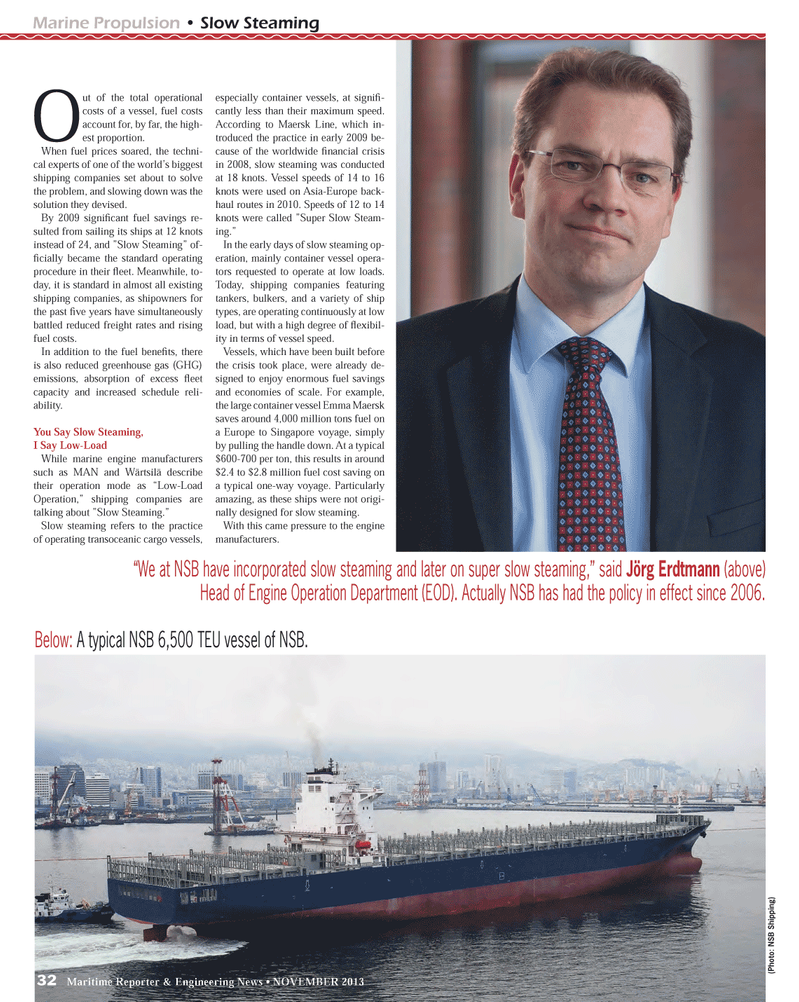
Page 32: of Maritime Reporter Magazine (November 2013)
Marine Propulsion Annual
Read this page in Pdf, Flash or Html5 edition of November 2013 Maritime Reporter Magazine
Marine Propulsion ? Slow SteamingOut of the total operational costs of a vessel, fuel costs account for, by far, the high- est proportion. When fuel prices soared, the techni-cal experts of one of the world?s biggest shipping companies set about to solve the problem, and slowing down was the solution they devised. By 2009 signiÞ cant fuel savings re- sulted from sailing its ships at 12 knots instead of 24, and ?Slow Steaming? of-Þ cially became the standard operating procedure in their ß eet. Meanwhile, to- day, it is standard in almost all existing shipping companies, as shipowners for the past Þ ve years have simultaneously battled reduced freight rates and rising fuel costs. In addition to the fuel beneÞ ts, there is also reduced greenhouse gas (GHG) emissions, absorption of excess ß eet capacity and increased schedule reli-ability. You Say Slow Steaming, I Say Low-LoadWhile marine engine manufacturers such as MAN and Wärtsilä describe their operation mode as ?Low-Load Operation,? shipping companies are talking about ?Slow Steaming.?Slow steaming refers to the practice of operating transoceanic cargo vessels, especially container vessels, at signiÞ -cantly less than their maximum speed. According to Maersk Line, which in-troduced the practice in early 2009 be-cause of the worldwide Þ nancial crisis in 2008, slow steaming was conducted at 18 knots. Vessel speeds of 14 to 16 knots were used on Asia-Europe back- haul routes in 2010. Speeds of 12 to 14 knots were called ?Super Slow Steam-ing.? In the early days of slow steaming op-eration, mainly container vessel opera-tors requested to operate at low loads. Today, shipping companies featuring tankers, bulkers, and a variety of ship types, are operating continuously at low load, but with a high degree of ß exibil-ity in terms of vessel speed.Vessels, which have been built before the crisis took place, were already de-signed to enjoy enormous fuel savings and economies of scale. For example, the large container vessel Emma Maersk saves around 4,000 million tons fuel on a Europe to Singapore voyage, simply by pulling the handle down. At a typical $600-700 per ton, this results in around $2.4 to $2.8 million fuel cost saving on a typical one-way voyage. Particularly amazing, as these ships were not origi-nally designed for slow steaming.With this came pressure to the engine manufacturers. ?We at NSB have incorporated slow steaming and later on super slow steaming,? said Jörg Erdtmann (above) Head of Engine Operation Department (EOD). Actually NSB has had the policy in effect since 2006. Below: A typical NSB 6,500 TEU vessel of NSB. (Photo: NSB Shipping)32 Maritime Reporter & Engineering News ? NOVEMBER 2013 MR #11 (26-33).indd 32MR #11 (26-33).indd 3211/11/2013 11:54:38 AM11/11/2013 11:54:38 AM

 31
31

 33
33
